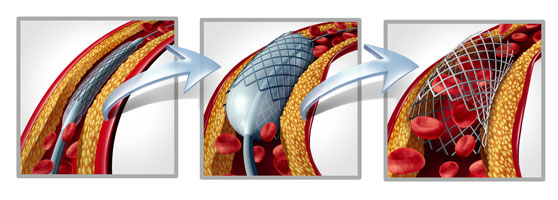Angioplasty and Stenting
Catheter Angiogram including Angioplasty and Stents

An angiogram is an imaging test that uses a special dye and X-ray images to take pictures of blood flow in arteries. This test is used to diagnose abnormalities such as narrowing, enlargement, malformed and blocked arteries in various parts of your body. Study of the arteries is called arteriogram and study of the veins is known as venogram.
What are the indications for catheter angiogram?
Although other modern investigations like CT and MRI give detailed information about the arteries, an angiogram may be indicated for a more detailed visualisation of the arteries in severe arterial disease so as to help plan the best possible treatment strategy.
In instances where plaque build-up causes narrowing of the arteries (peripheral artery disease and atherosclerosis), the angiogram can often be combined with an angioplasty. In angioplasty, a catheter with a balloon attached to the end of it is inserted into the artery and inflated to open up the narrowing for improved blood flow.
Are there any specific preparation before an angiogram?
Before an angiogram, inform your doctor if you are pregnant, breast-feeding, asthmatic, have bleeding problems, or any allergies to iodine dye, bee stings or shellfish. Your doctor will ask you about the medicines you are taking and review your history. Your doctor may order certain blood tests to determine your blood’s clotting ability and kidney functions. You will be asked to stop medicines that prevent clotting. Your doctor will advise you to avoid drinking for 6 hours before the procedure. You will also be asked to empty your bladder before the test begins.
What does the procedure involve?
The following steps are involved in performing an angiogram:
- You will lie on your back on an X-ray table. Your doctor will insert an intravenous line in the vein of your arm to provide the required medicines and fluids.
- A pulse oximeter will be placed on your finger or ear to measure the levels of oxygen in your blood. Electrodes will be placed on your arms, chest or legs to record your heart rhythm and heart rate.
- The groin or region above the elbow where the catheter is to be inserted will be cleaned, shaved and numbed with a local anaesthetic.
- Your doctor will insert a guide wire through a needle into the blood vessel, after which the needle is removed. The catheter (thin long plastic tube) will then be inserted into the blood vessel over the guide wire and advanced to the area to be studied. A fluoroscope (real time X-ray) will be used to monitor the path of the catheter in the blood vessel.
- The iodine dye will be injected through the catheter and images will be taken to check the flow of the dye through the blood vessel. You may be asked to hold your breath for a few seconds whilst the X-ray images are acquired.
- After discussing with you, the surgeon may then decide to go ahead to treat the narrowed or blocked artery. This can be performed by angioplasty which involves inflating a balloon which is mounted at the tip of the catheter. Sometimes a stent which is like a metal scaffolding may also have to be used to reline the inside wall of the artery to keep it open.
- After the angiogram, the catheter is removed and pressure is applied on the needle site to help stop bleeding. The site is then covered with a bandage. The entire procedure takes 1 to 3 hours to complete depending on whether other procedures such as angioplasty are performed.
Is there any specific post-procedural care?
Following the procedure, bed rest is recommended for several hours. Ice packs can be used to relieve pain and swelling over the needle puncture site. You will be prescribed medication to relieve any discomfort. If the catheter was inserted in your arm, avoid blood tests and blood pressure measurements for several days after the procedure. If the catheter was inserted in the groin area, the leg should be kept straight for about 6 hours. You will be asked to drink plenty of fluids to prevent dehydration and flush the dye through the kidney. Avoid strenuous exercises and activities such as walking, climbing stairs and driving for at least 12 hours after the procedure.
Are there any risks and complications?
As with any procedure, angiogram includes potential risks and complications. These include:
- Bleeding or severe bruising at the injection site
- Blood vessel damage and blockage
- Rarely, kidney damage or severe allergic reaction to the dye
